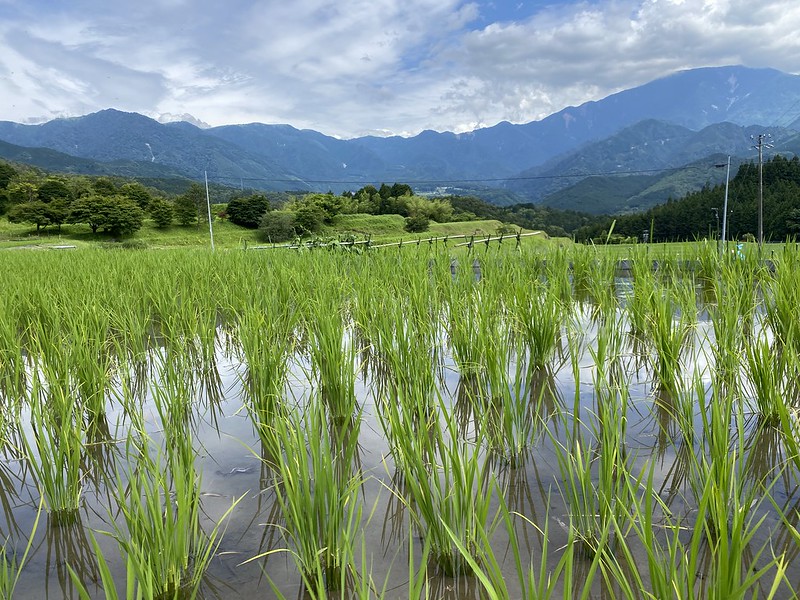Today was our big planned walking day. We’re in Nakatsugawa because it provides access to a popular part of the Nakasendo, one of the Edo period walking trails from Tokyo to Kyoto.
We got up and had a quick breakfast, then departed to make the train leaving for Nagiso at 08:14. Yesterday when we arrived at Nakatsugawa station, I’d checked the timetable for trains leaving for Nagiso in the morning. Reading the poster I thought it said that there were trains departing at 08:14 and then 10:00, with no trains in between except for expresses that required reserved seating and significant extra cost. I asked a staff member at the station and her confirmed this. So rather than wait until 10:00, we made sure to get the 08:14 train.
We tapped our Apple wallet Suica cards on the station gates, climbed over the stairway to the other platform, and boarded the two-carriage train that was waiting there to depart. We had several minutes to wait, and it was lucky we did, because there was an automated announcement on the train in Japanese and then English, saying that Suica cards were not accepted beyond Nakatsugawa, and anyone on the train needed to pay the driver on the way off the train. We could do that, but we needed to cancel our Suica taps somehow, lest the system get confused and end up charging us some wrong amount, or not letting us on our next train. So I ran back over the stairs with both our phones and spoke to a staff member, who nodded knowingly and told me to tap the phones on a pad there, which he programmed to cancel our previous tap-ons. He then said I should buy tickets to Nagiso, which I did, before running back over the stairs to get back on the train before it departed. It wasn’t actually close, as I made it with 2 or 3 minutes to spare.
The train took us up the river valley into the mountains, into countryside a lot wilder and less settled than any we’d seen on the way to Nakatsugawa. The rocky river and the forested mountains on both sides were beautiful. We arrived at Nagiso at 08:30 and alighted the train with about 6 or 7 other passengers. It’s obviously not a heavily travelled line.
We left the station to take a brief look around the tiny village of Nagiso, and a small cafe was just opening. We went in, but the man had retired to a back room and I had to call out “sumimasen” loudly a couple of times before he heard and bustled out. My wife ordered her coffee to go and we set out.
Right near the station we saw a sign pointing the way to the Nakasendo, leading us over the train line on a small pedestrian bridge, and then along the road above for a bit. Soon the path left the road and we were walking along narrow laneways with a few scattered houses. There was a little car traffic, but not much, and the path became narrower and less vehicle-friendly. We crossed a few small bridges and the scenery became pleasantly rural, but not really wilderness.
A few kilometres down the path we reached Tsumago-juku, the first of the historic post towns along the route where travellers could stop to rest. This was essentially an old village laid out along the trail, with well-preserved historic wooden buildings. Some of them were private residences, but many had been turned into shops or cafes or restaurants to serve modern customers. It was very pretty to walk along, and not at all crowded, with just a few tourists walking around. It may have been too early, as many of the shops hadn’t opened yet.
Continuing along the Nakasendo, we soon found ourselves walking along a foot trail uphill through thick pine forest. It was really beautiful, with a feeling like Sam and Frodo walking across parts of Middle-earth. Occasionally the path popped out at a small cluster of houses or a lone building, and some of these offered refreshments. There were also several toilet buildings along the way. But the main next goal was Magome-juku, the next post town along the route. This was up the mountain and over Magome Pass. There was a road running up to the pass as well, but the Nakasendo mostly followed a foot route running parallel, occasionally popping out to cross the road or go along it briefly before heading back into the forest. But at one point near the Otaki-Metaki Waterfalls there was a detour due to the Nakasendo path being closed because of some sort of small disaster, presumably a land slip or rockfall or something. So we had to detour past the waterfalls – which was in a sense fortunate otherwise we might not have seen them at all, and they were worth seeing. The detour took us along the main road for a few hundred metres before we rejoined the Nakasendo route through the forest.
The forest was a mixture of pines with large stands of giant bamboo in places, and very beautiful. The going got tough as we ascended to Magome Pass, with the trail becoming steeper. We started to notice people walking the opposite direction, heading to Tsumago-juku. They seemed happy to be walking downhill while we puffed slowly past them. Eventually we topped out at Magome Pass, 790 metres above sea level. Nagiso, where we’d begun walking, is at 411 metres. From here it was all downhill! Almost.
We walked down and it was a bit under an hour to Magome-juku. By now it was lunch time and we stopped in at a small place that offered simple soba and udon meals. We both had cold noodles with wild vegetables, my wife getting soba while I had udon. We wanted cold instead of hot because it was a hot day and the sun had come out, and it was also very humid, so we’d become very hot walking. Resting in the shade of the restaurant with a fan blowing cool air was a pleasant relief. We also tried a goheimochi coated with a sauce of sesame, walnuts, soy sauce, sugar, and sweet sake. These were really delicious, with the nutty flavour making them much better than mitarashi dango which we’d had at Nishiki Market in Kyoto.
After eating we resumed our walk. Most people get a bus to or from Magome-juku, but we had decided to walk all the way back to Nakatsugawa. The Nakasendo continued, through a rural area full of houses with vegetable gardens, rice paddies, and we even saw some grape vines. This was a nice countryside to walk through, and I’m very glad we did it.
Eventually we reached built up areas again, part of which was the next Nakasendo post town of Ochiai-juku. This was not as preserved as the previous two, with many of the original buildings being redeveloped into more modern houses. The honjin or government inn was preserved there, but closed for the public. We continued on and stopped at the nearby Genky Ochiai supermarket/drug store to buy some cold drinks: ginger ale for me and green tea for my wife. We drank sitting inside the lovely air conditioning before setting out for the final leg back into Nakatsugawa.
This involved walking uphill over a couple of large hills and back down again, since we took some quiet back streets to avoid the bust main road that skirted around the base of the hills. But it was good that we did this because we passed signs indicating that this was still the original Nakasendo route. It took us down a final steep hill into Nakatsugawa, just a couple of blocks from our hotel.
We stopped and rested for a bit, and I had a cold shower to wash off the walking grime and cool down, before dressing in fresh clothes for dinner. I tried looking for any restaurants nearby that might have vegetarian food, but we decided to just go to the nearby shopping mall and try whatever they had there. It was a small mall, and we ended up just getting some take-way sushi and taking it up to eat at the food court tables. After that we had some ice cream at a Baskin Robins. This was our first non-Japanese food of the trip, but we both felt like it after the hard day of walking.
We’d walked 21.5 kilometres, climbed a total of 683 metres of elevation, and I walked 32,150 steps. Phew!



